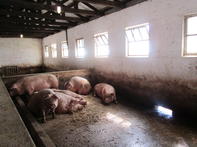
Signs and Symptoms
Symptoms and the severity of an infection will vary, depending on the organisms involved, but typically include lethargy, fever, anorexia, loss of appetite, poor growth, nasal and eye discharges, coughing and often a purple discolouration of the skin, especially on the tips of the ears. It may also result in sudden death.Causes
Dusty conditions, toxic gasses such as ammonia, poor ventilation, cold exposure, extreme temperature fluctuations, excessive humidity, overcrowding and stress may all predispose pigs to Porcine Respiratory Disease Complex. In South Africa, the condition is associated with Coronavirus, Circovirus, Porcine Reproductive and Respiratory Syndrome.
Bacteria, according to Modern Pig Production, that may be involved are Bordetella bronchiseptica, Pasteurella multocida, Haemophilus parasuis, Antinobaccilus pleuropneumoniae, Actinobaccillus suis and Actinobacillus equuli, Streptococcus suis and Mycoplasma hyopneumoniae, also known as Enzootic Pneumonia.
Each of the bacteria has various serotypes that affect pigs differently in terms of the symptoms, seriousness of the disease and the ages at which pigs are most vulnerable to outbreaks. The pathogens may cause mild diseases on their own, but become very serious when they occur with other pathogens.
Prevention

Due to the complex nature of the disease, Modern Pig Production advises farmers to consult a veterinarian for a prevention, control and treatment plan. Strict biosecurity will help by preventing healthy pigs from getting in to contact with disease carriers, which may be anything from other pigs to pets, people, clothing to work implements.
Pigs should be moved and mixed as little as possible and preferably be kept in the same age group from birth, or when they arrive on the farm, until they leave the farm. Such an all-in-all-out system will help to thoroughly clean a production unit before new pigs are placed in it.
Good sanitization and regular cleaning of drinkers, feeders and pens will prevent a build-up of disease-carrying organisms or toxic gasses, such as ammonia. Along with good ventilation, this will help to ensure good air quality in the production area. Pigs should also be sheltered from adverse climatic conditions, not be overcrowded and handled as little as possible to minimise stress.
Vaccines are available to prevent some of these diseases, but it is best to consult a veterinarian to identify which are important in your production area. Regular deworming will reduce the risk of infection caused by worms that live or move through the lungs.
Some of the outbreaks can be treated with medicine, depending on the organisms involved. Prevention, nevertheless, remains the best medicine.
By Glenneis Kriel